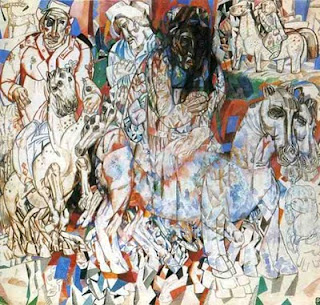I found myself asking if Petersburg constituted the first "Post-Modern" novel? So many of the elements we now regard as "Post-Modern" are right here in Bely's "Astral Novel" from 1913. Seems that the Post-Modernists stole from the pages of Symbolist literature.
Bely shifts back and forth in time effortlessly, with the events in the novel all taking place within a span of two days. The ticking clock inside the homemade bomb, hidden in a sardine can, comes to dominate the second half of the novel. The tension is wonderfully wrought, as Bely moves back and forth between a handful of characters in those fateful hours of the strikes that would bring about the first Russian revolution of 1905. Nikolai Apollonovich finds himself breaking these hours down into seconds, with each one ticking away slowly on a collision course with "zero."
Meanwhile, his father contemplates the distance that has grown between his son and him, and in snooping around his son's room comes across the sardine tin, not sure what to make of it. He thinks it is some kind of toy from his son's past and takes it to the library for closer examination.
Nikolai struggles to get himself free of various entanglements, including an old friend who feels Nikolai has dishonored his wife and is demanding an explanation. But, the real nemesis is Lippanchenko, who appears to be taking advantage of not only the restless young nobility in persons like Nikolai and Sofia Petrovna, but the general unrest of the city.
Lippanchenko remains a shadowy figure throughout the novel. Nikolai's dealings are mostly with Alexander Ivanovich, who seems to be the only one who understands the meaning of the revolution taking place. But, numerous misunderstandings and the nefarious activities of Lippanchenko threaten to unhinge everything. Reminded me a lot of Dostoevsky's Demons in this regard.
Through it all, Apollon Apollonovich tries to maintain his decorum, but even he feels it is sagging under the pressure of events taking place. When his wife, and the mother of son, unexpectedly returns, there seems an opportunity for rebirth, but ultimately this is a tale of disillusionment.
The novel has been compared to Joyce's Ulysses, mostly I think in the way the two authors dealt with the concept of time. Petersburg pretty much remained an obscure novel until first translated into English in the 1959. Cournos was very familiar with events in Russia at the time of the second revolution, having traveled to Petersburg in 1917. He provides some background to the novel in his introduction, but not much in the way of insight into how Bely composed this novel. It appears the recent Ellsworth translation sheds much needed new light on the novel.
_______________________________________________
The painting is The Magi (1914) by Pavel Filonov

Comments
Post a Comment